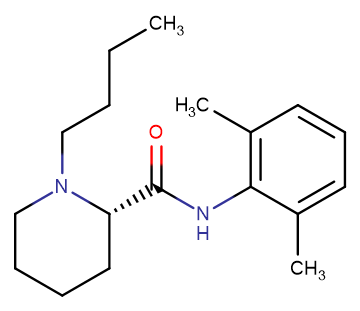
Levobupivacaine
CAS No. 27262-47-1
Levobupivacaine( —— )
Catalog No. M13834 CAS No. 27262-47-1
Levobupivacaine is an amino-amide local anaesthetic drug belonging to the family of n-alkylsubstituted pipecoloxylidide.
Purity : >98% (HPLC)
 COA
COA
 Datasheet
Datasheet
 HNMR
HNMR
 HPLC
HPLC
 MSDS
MSDS
 Handing Instructions
Handing Instructions
| Size | Price / USD | Stock | Quantity |
| 2MG | 43 | In Stock |


|
| 5MG | 36 | In Stock |


|
| 10MG | 51 | In Stock |


|
| 25MG | 85 | In Stock |


|
| 50MG | 124 | In Stock |


|
| 100MG | 178 | In Stock |


|
| 200MG | 267 | In Stock |


|
| 500MG | 461 | In Stock |


|
| 1G | Get Quote | In Stock |


|
Biological Information
-
Product NameLevobupivacaine
-
NoteResearch use only, not for human use.
-
Brief DescriptionLevobupivacaine is an amino-amide local anaesthetic drug belonging to the family of n-alkylsubstituted pipecoloxylidide.
-
DescriptionLevobupivacaine is an amino-amide local anaesthetic drug belonging to the family of n-alkylsubstituted pipecoloxylidide. It is the S-enantiomer of bupivacaine. Levobupivacaine hydrochloride is commonly marketed by AstraZeneca under the trade name Chirocaine. Compared to bupivacaine, levobupivacaine is associated with less vasodilation and has a longer duration of action. It is approximately 13 per cent less potent (by molarity) than racemic bupivacaine.Levobupivacaine is indicated for local anaesthesia including infiltration, nerve block, ophthalmic, epidural and intrathecal anaesthesia in adults; and infiltration analgesia in children. Adverse drug reactions (ADRs) are rare when it is administered correctly. Most ADRs relate to administration technique (resulting in systemic exposure) or pharmacological effects of anesthesia, however allergic reactions can rarely occur. (In Vitro):Levobupivacaine (0-4 mM; 24 h) does not affect the viability of GES-1 cells but inhibits the viability of HGC27 and SGC7901 cells.Levobupivacaine (2 mM; 24, 48 or 72 h) enhances Erastin-induced inhibitory impact on HGC27 and SGC7901 cell viabilities; induces the levels of Fe2+, iron, and lipid ROS.Levobupivacaine (2 mM; 24 h) enhances the expression of miR-489-3p in HGC27 and SGC7901 cells, increases the levels of Fe2+ and iron.(In Vivo):Levobupivacaine (40 μmol/kg; IP; once daily for 25 days) significantly inhibits SGC7901 cell growth, and enhances the lipid ROS accumulation.Levobupivacaine (5 or 36 mg/kg; IP; single dosage) increases the latency to partial seizures and prevents the occurrence of generalized seizures at low dosage; reduces the latency to N-methyl-d-aspartate (NMDA)-induced seizures and increased seizure severity at high dosage.
-
In VitroLevobupivacaine (0-4 mM; 24 h) does not affect the viability of GES-1 cells but inhibits the viability of HGC27 and SGC7901 cells.Levobupivacaine (2 mM; 24, 48 or 72 h) enhances Erastin-induced inhibitory impact on HGC27 and SGC7901 cell viabilities; induces the levels of Fe2+, iron, and lipid ROS.Levobupivacaine (2 mM; 24 h) enhances the expression of miR-489-3p in HGC27 and SGC7901 cells, increases the levels of Fe2+ and iron. Cell Viability Assay Cell Line:GES-1, HGC27 and SGC790 Concentration:0, 0.5, 1, 2 and 4 mMIncubation Time:24 h Result:Did not affect the viability of normal gastric epithelial GES-1 cell lines but inhibited the viability of HGC27 and SGC7901 cells in a dose-dependent manner.Cell Viability AssayCell Line:HGC27 and SGC7901 (incubated with 5 μM erastin)Concentration:2 mM Incubation Time:24, 48 or 72 h Result:Enhanced erastin-induced inhibitory impact on HGC27 and SGC7901 cell viabilities; induced the levels of Fe2+, iron, and lipid ROS.RT-PCRCell Line:HGC27 and SGC7901 (incubated with 5 μM erastin)Concentration:2 mMIncubation Time:24 hResult:Enhanced the expression of miR-489-3p in HGC27 and SGC7901 cells, increased the levels of Fe2+ and iron.
-
In VivoLevobupivacaine (40 μmol/kg; IP; once daily for 25 days) significantly inhibits SGC7901 cell growth, and enhances the lipid ROS accumulation.Levobupivacaine (5 or 36 mg/kg; IP; single dosage) increases the latency to partial seizures and prevents the occurrence of generalized seizures at low dosage; reduces the latency to N-methyl-d-aspartate (NMDA)-induced seizures and increased seizure severity at high dosage. Animal Model:CD1 mice (30-35 g; induced epileptic seizures by injecting with NMDA)Dosage:5 or 36 mg/kg Administration:IP; single dosage Result:Increased the latency to partial seizures and prevented the occurrence of generalized seizures at 5 mg/kg; reduced the latency to NMDA-induced seizures and increased seizure severity at 36 mg/kg.Animal Model:SCID nude mice (6-8 weeks; subcutaneously injected with 5×106 SGC7901 cells)Dosage:40 μmol/kg Administration:IP; once daily for 25 days Result:Significantly inhibited SGC7901 cell growth, and enhanced the lipid ROS accumulation.
-
Synonyms——
-
PathwayMembrane Transporter/Ion Channel
-
TargetSodium Channel
-
RecptorSodium Channel
-
Research Area——
-
Indication——
Chemical Information
-
CAS Number27262-47-1
-
Formula Weight288.43
-
Molecular FormulaC18H28N2O
-
Purity>98% (HPLC)
-
SolubilitySoluble in DMSO
-
SMILESCCCCN1CCCC[C@H]1C(=O)NC2=C(C=CC=C2C)C
-
Chemical Name——
Shipping & Storage Information
-
Storage(-20℃)
-
ShippingWith Ice Pack
-
Stability≥ 2 years
Reference
1.Ueta K, et al. Reg Anesth Pain Med. 2006 Jan-Feb;31(1):19-25.
molnova catalog



related products
-
Benzonatate
Benzonatate is an antagonist of sodium channel protein.Na(+) currents are inhibited most potently by a benzonatate fraction containing the 9-ethoxy component.?
-
Ralfinamide
Ralfinamide is an orally available Na-channel blocker for the treatment of neuropathic pain and other pain conditions.
-
Tetracaine hydrochlo...
Tetracaine hydrochloride (Pontocaine) is a hydrochloride salt form of tetracaine which is a potent local anaesthetic and a channel function allosteric inhibitor.



 Cart
Cart
 sales@molnova.com
sales@molnova.com


